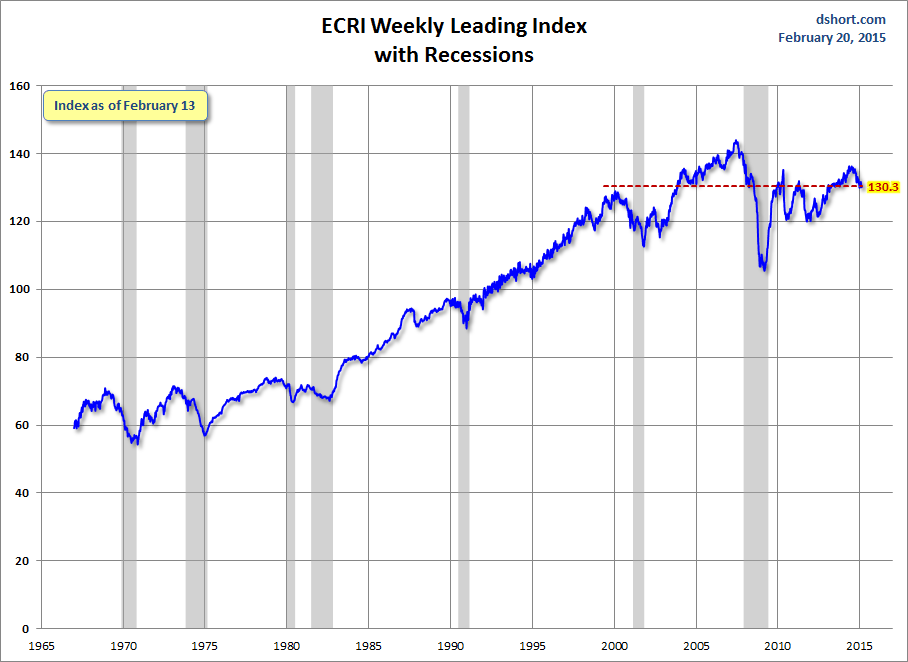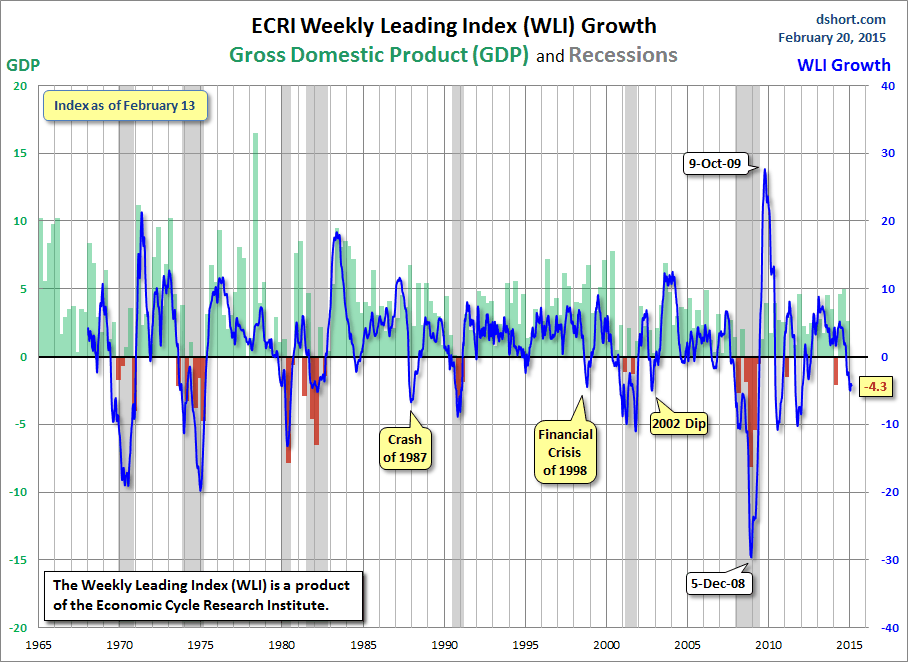Today's new release of the publicly available data from the Economic Cycle Research Institute (ECRI) puts its Weekly Leading Index (WLI) at 130.3, up slightly from 130.0 the previous week. The WLI annualized growth indicator (WLIg) is at -4.3, unchanged from the previous week but off the interim low of -5.0 in mid-January.
Conflicting Concerns
The title for the ECRI's latest public report (full report requires a subscription) offers an interesting perspective on the January Fed Minutes released on Wednesday. Here is ECRI's opening observation:
The January Fed minutes released this week were dominated, as usual, by a litany of conflicting concerns. Buried within it, though, was a significant sentence echoing our apprehension that the available policy tools have become unworkable: "The risks to the forecast for real GDP growth were viewed as tilted a little to the downside, reflecting the staff's assessment that neither monetary policy nor fiscal policy was well positioned to help the economy withstand adverse shocks." (italics ours). The desire to be better positioned to counter negative shocks lies at the root of the Fed's reluctance to push off rate hikes. |
The ECRI Indicator Year-over-Year
Below is a chart of ECRI's smoothed year-over-year percent change since 2000 of their weekly leading index. I've highlighted the 2011 date of ECRI's original recession call and the hypothetical July 2012 business cycle peak, which the company previously claimed was the start of a recession. I've update the chart to include the "epicenter" (Achuthan's terminology) of the hypothetical recession.

Appendix: A Closer Look at the ECRI Index
The first chart below shows the history of the Weekly Leading Index and highlights its current level.

For a better understanding of the relationship of the WLI level to recessions, the next chart shows the data series in terms of the percent off the previous peak. In other words, a new weekly high registers at 100%, with subsequent declines plotted accordingly.

As the chart above illustrates, only once has a recession ended without the index level achieving a new high -- the two recessions, commonly referred to as a "double-dip," in the early 1980s. Our current level is still off the most recent high, which was set back in June of 2007. We've exceeded the previously longest stretch between highs, which was from February 1973 to April 1978. But the index level rose steadily from the trough at the end of the 1973-1975 recession to reach its new high in 1978. The pattern in ECRI's indictor is quite different, and this has no doubt been a key factor in their business cycle analysis.
The WLIg Metric
The best known of ECRI's indexes is their growth calculation on the WLI. For a close look at this index in recent months, here's a snapshot of the data since 2000.

Now let's step back and examine the complete series available to the public, which dates from 1967. ECRI's WLIg metric has had a respectable record for forecasting recessions and rebounds therefrom. The next chart shows the correlation between the WLI, GDP and recessions.

The History of ECRI's Latest Recession Call
ECRI's weekly leading index has become a major focus and source of controversy ever since September 30, 2011, when ECRI publicly announced that the U.S. is tipping into a recession, a call the Institute had announced to its private clients on September 21st. Here is an excerpt from the announcement:
Early last week, ECRI notified clients that the U.S. economy is indeed tipping into a new recession. And there's nothing that policy makers can do to head it off. ECRI's recession call isn't based on just one or two leading indexes, but on dozens of specialized leading indexes, including the U.S. Long Leading Index, which was the first to turn down — before the Arab Spring and Japanese earthquake — to be followed by downturns in the Weekly Leading Index and other shorter-leading indexes. In fact, the most reliable forward-looking indicators are now collectively behaving as they did on the cusp of full-blown recessions, not "soft landings." (Read the report here.) |
Year-over-Year Growth in the WLI
Triggered by another ECRI commentary, Why Our Recession Call Stands, I include a snapshot of the year-over-year growth of the WLI rather than ECRI's previously favored method of calculating the WLIg series from the underlying WLI (see the endnote below). Specifically the chart immediately below is the year-over-year change in the 4-week moving average of the WLI. The red dots highlight the YoY value for the month when recessions began.

The WLI YoY is deep in the negative zone, now at -1.6% and off its interim low of -2.4% set four weeks earlier. The latest level is lower than the outset of four of the seven recessions during ECRI's published data series. This indicator has only rarely dipped below its recent interim low outside recessionary periods: Lower levels occurred in 1988 and also during the economic volatility following the last recession.
Additional Sources for Recession Forecasts
Dwaine van Vuuren, CEO of RecessionAlert.com, and his collaborators, including Georg Vrba and Franz Lischka, have developed a powerful recession forecasting methodology that shows promise of making forecasts with fewer false positives, which I take to include excessively long lead times, such as ECRI's September 2011 recession call.
Here is today's update of Georg Vrba's analysis, which is explained in more detail in this article.

Earlier Video Chronology of ECRI's Recession Call
- September 30, 2011 : Recession Is "Inescapable" (link)
- September 30, 2011 : Tipping into a New Recession (link)
- February 24, 2012 : GDP Data Signals U.S. Recession (link)
- May 9, 2012 : Renewed U.S. Recession Call (link)
- July 10, 2012 : "We're in Recession Already" (link)
- September 13, 2012 : "U.S. Economy Is in a Recession" (link)
Note: How to Calculate the Growth series from the Weekly Leading Index
ECRI's weekly Excel spreadsheet includes the WLI and the Growth series, but the latter is a series of values without the underlying calculations. After a collaborative effort by Franz Lischka, Georg Vrba, Dwaine van Vuuren and Kishor Bhatia to model the calculation, Georg discovered the actual formula in a 1999 article published by Anirvan Banerji, the Chief Research Officer at ECRI: " The three Ps: simple tools for monitoring economic cycles - pronounced, pervasive and persistent economic indicators."
Here is the formula:
"MA1" = 4 week moving average of the WLI"MA2" = moving average of MA1 over the preceding 52 weeks
"n"= 52/26.5
"m"= 100
WLIg = [m*(MA1/MA2)^n] – m
